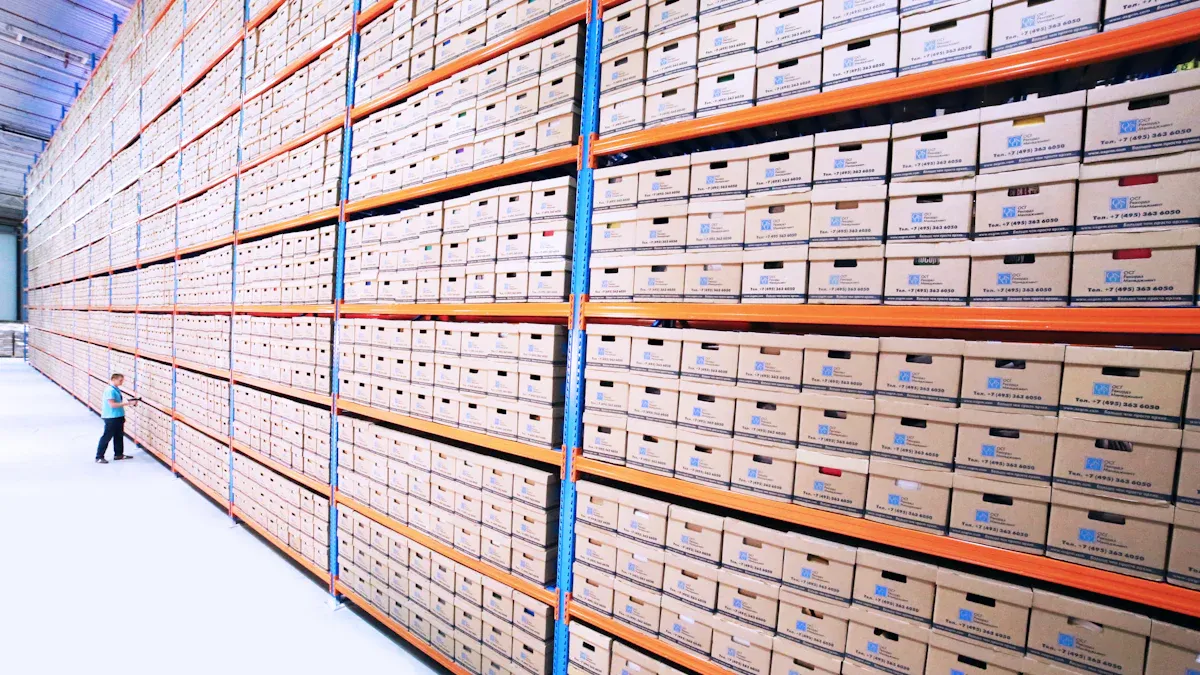Fully Managed Warehouse vs. Managed Spark

You want quick answers and trustworthy insights for business intelligence. A Managed Warehouse works best when you need organized analytics, reports, and simple growth. You pick managed Spark for live analytics, connecting to a data lake, or machine learning jobs.
Amazon Redshift has almost 16% of the data warehousing market.
Snowflake’s cloud-based model competes with older options.
Managed Spark helps handle streaming data and supports machine learning with fast memory.
Choose the right tool for your data needs.
Key Takeaways
Pick a Managed Warehouse if you want organized analytics. It helps you find data easily. Reporting is simple with it. Business teams can use it without trouble.
Pick Managed Spark for advanced analytics and machine learning. It works fast with big datasets. It can handle real-time data too. You get more choices with it.
Think about your team's skills before you choose. Managed Warehouses are easy for beginners. Managed Spark needs you to know coding.
Plan for growth in your business. Both options can grow with you. They do this in different ways. Managed Warehouses take care of storage. Managed Spark changes how much power it uses.
Look at what your team needs. Use a Managed Warehouse for easy reporting. Use Managed Spark for hard data jobs like ETL and machine learning.
Quick Comparison
Analytics and BI
You want to make reports and dashboards fast and right. A Managed Warehouse lets you keep your data neat and easy to find. It helps you do business intelligence jobs like checking sales or customer habits. The platform stores your data in one spot and keeps it safe. You do not have to handle files or worry about old data.
Tip: Managed Warehouses are best for good analytics and simple access for lots of users.
Here is a quick way to see how these systems store data:
Feature | Managed Warehouse Tables | External Tables (Spark) |
|---|---|---|
Control | Platform manages everything | You manage files, platform tracks info |
Data Storage | Stored in warehouse directory | Stored in places like S3 |
Lifecycle | Data removed with table deletion | Data stays after table deletion |
Use Case | Internal analytics, ETL results | Sharing data, querying existing files |
Spark external tables give you more control, but you must take care of the files. Managed Warehouse tables make analytics easier.
Data Engineering and ML
You need to work with lots of data or build machine learning models. Managed Spark gives you speed and lets you do many things. You can use streaming data and do advanced analytics. Spark works with many formats and links to data lakes. It runs fast, but fixing problems and tuning jobs can be hard.
Here is a short list of what Spark does well and where it is tough:
Strengths | Limitations |
|---|---|
Fast performance | Hard to debug and tune |
Flexible and compatible | Can cost more due to memory use |
Not always real-time |
You can use Spark for hard data engineering jobs. You should plan for higher costs and more tech work. Managed Warehouse is easier for simple analytics, but Spark is better for big data and machine learning.
Core Differences
Storage vs. Processing
You need to know how each system handles your data. A Managed Warehouse stores your data in a structured way. You put your information into tables, and the platform keeps everything organized. You do not have to worry about where files go or how to clean up old data. The system takes care of storage for you.
Spark works differently. You use Spark to process data, not just store it. You can read files from many places, like cloud storage or data lakes. Spark lets you move and change data quickly. You control where files live and how you use them. You need to manage your files and make sure they are safe.
Note: If you want easy storage and simple data management, choose a Managed Warehouse. If you want to process large amounts of data from many sources, Spark gives you more control.
User Experience
You want a tool that fits your skills and needs. A Managed Warehouse gives you a simple interface. You can run queries, build dashboards, and share reports with your team. The platform handles updates and security. You do not need to set up servers or fix problems.
Spark gives you more power, but you need technical skills. You write code to run jobs and manage clusters. You can use many programming languages, like Python or Scala. Spark works well for data engineers and scientists who want to build custom solutions.
Managed Warehouse: Easy to use, good for business users, quick setup.
Spark: Flexible, good for technical users, needs more setup.
Tip: Pick a Managed Warehouse if you want fast results and less work. Use Spark if you need advanced features and can handle more complexity.
Managed Warehouse Overview

Definition
A Managed Warehouse is a place in the cloud for your data. You do not need to buy or set up servers. The provider keeps everything safe and up to date. They also make sure your data is backed up. You can use your data for reports and dashboards. This helps you make good business choices. Your information stays safe and easy to find.
Key Features
A Managed Warehouse gives you many useful features. These features help you work better and grow your business. Here is a table that lists some top features and what they mean:
Feature | Description |
|---|---|
Customized to you | You can change settings to match what you need. |
Grows with you | The system can hold more data as you grow. |
Learning Curve | The interface is simple, so you learn it fast. |
Beyond storage | You get extra tools for shipping, labor, and finance. |
You also get these important benefits:
You can see your inventory right away, so you always know what is there.
The system works with other tools, so you do not have to do as much by hand.
You can check how your team is doing with labor tools.
The warehouse gets bigger as your business grows, so you always have space.
You can make custom reports and see analytics to help you decide what to do.
Tip: A Managed Warehouse makes it easy to handle your data and helps your business as it changes.
Managed Spark Overview

Definition
Managed Spark lets you work with big data in the cloud. You do not need to set up servers yourself. The service does the hard work for you. You can run Spark jobs and change how much power you use. You can connect to other cloud tools. You do not have to install software or fix hardware. The provider handles updates, security, and backups. You can focus on your data jobs, like analytics or machine learning.
Managed Spark is good for handling lots of data fast. You can use it for cleaning data or making models. You can also run reports. The system grows as your needs grow. You can start small and add more power later.
Key Features
Managed Spark platforms have many helpful features for big data. Here is a table that shows what some top providers give you:
Service Provider | Features |
|---|---|
Amazon EMR | Gives you Spark clusters managed by AWS. It works with other AWS services. |
Google Cloud Dataproc | Has managed Spark and Hadoop. It connects easily with Google Cloud services. |
Azure Databricks | Lets you set up, grow, and stop Spark clusters when you need to. |
You get many good things when you use managed Spark:
You can change resources to fit your workload.
The platform has serverless options that save money.
You can look at big datasets without buying servers.
You can do batch jobs, streaming, and machine learning all together.
Spark works with other big data tools like Hadoop and Hive.
Note: Spark can process data much faster than old systems like Hadoop MapReduce because it keeps data in memory. This speed helps you finish jobs quickly and repeat tasks without waiting.
Managed Spark gives you the speed and flexibility you need for new data projects. You can focus on your work while the platform takes care of everything else.
Comparison
Architecture
These two systems are built in different ways. A Managed Warehouse gives you a neat place for your data. The provider sets up everything for you. You do not need to worry about servers or storage. You put your data into tables. The system keeps things organized. This is good for business intelligence and reports.
Managed Spark works another way. You use clusters to process data from many places. These places can be data lakes or cloud storage. You can make clusters bigger or smaller when you need. Spark clusters handle batch and streaming data. You get more control, but you must manage jobs and data locations.
Feature | Managed Warehouse | Managed Spark |
|---|---|---|
Data Storage | Structured tables | Files in data lakes or cloud storage |
Compute | Handled by provider | User-managed clusters |
Data Processing | SQL queries | Batch and streaming jobs |
Integration | Easy with analytics tools | Flexible with many data sources |
Tip: Pick a Managed Warehouse for simple, neat storage. Pick Spark if you want to process data from many places.
Performance
You want answers from your data fast. A Managed Warehouse gives you quick results for analytics and dashboards. The system uses indexing and partitioning to make searches faster. You can run many queries at the same time. The platform handles the work for you.
Managed Spark is great for big datasets and hard jobs. Spark uses memory to process data faster than old systems. You can use Spark for real-time analytics, streaming, and machine learning. Both systems let you see insights in seconds. Automatic streaming and partitioning help you handle lots of transactions quickly.
Managed Warehouse: Fast for structured queries and reports.
Managed Spark: Fast for big data, streaming, and advanced analytics.
Note: Spark is best for tough data engineering and machine learning. Managed Warehouse is better for business reports and dashboards.
Scalability
Your system needs to grow with your data. Both options can scale, but they do it differently.
You can make a Managed Warehouse bigger by adding storage or compute. The provider takes care of the details. You do not need to handle hardware.
Managed Spark lets you make clusters bigger or smaller for your workload. Autoscaling saves money by adding resources when busy and shrinking when done.
Both systems use rules to control data growth. You can set how long to keep data and when to archive it.
Audits and monitoring help you follow rules and keep data safe.
You can use compression, partitioning, and indexing to make storage and queries faster.
Spark clusters can grow for busy times or shrink when quiet. This helps with big changes in data volume.
Remember: Good rules and management help your system stay scalable and save money.
Cost
You want to know what you will pay. The cost is different for each platform.
Feature | Snowflake (Managed Warehouse) | Databricks (Managed Spark) |
|---|---|---|
Pricing Model | Credit-based consumption | Higher minimum operational cost |
Compute Resource Management | Bills for actual runtime, no costs when suspended | Cluster startup times impact costs |
Efficient use rewarded, autoscaling saves money | Better at scale for diverse workloads | |
Minimum Charges | 60-second minimum billing increments | N/A |
Managed Warehouse charges you for what you use. You pay for compute time and storage. If you pause your warehouse, you stop paying for compute.
Managed Spark may cost more because clusters must run for jobs. You save money when you run many different jobs.
Autoscaling in both systems helps you match resources to your needs.
Tip: Watch your usage and use autoscaling to save money.
Management
You want a system that is easy to handle. A Managed Warehouse gives you a simple experience. The provider does updates, security, and backups. You focus on your data and reports.
Managed Spark gives you more control. You must manage clusters, jobs, and resources. You can connect to many data sources and use advanced analytics. Security features keep your data safe. You get protection, encryption, and follow standards like SOC 2. Both systems let you set rules for who can see data and how it moves.
Integration Type | Description |
|---|---|
Stores lots of data for querying. It can also get data from the warehouse for other services. | |
Analytics and Reporting | Structured data from the warehouse is used for analysis, machine learning, and visualization. |
You can connect both systems to other cloud services for analytics, reporting, and machine learning.
Security features include protection, encryption, and following industry rules.
You can set up private endpoints and control access for better safety.
Note: Pick a Managed Warehouse for easy management and strong security. Use Spark if you want more control and flexibility.
Use Cases
Managed Warehouse
You can use a Managed Warehouse if you want an easy way to keep and look at your data. Many companies pick this because it grows with your business. You do not need to buy or fix hardware. Your data stays safe, and you can make data pipelines that fit your needs. This helps your team finish work faster.
You can use new data tools and build data pipelines.
You do not have to worry about hardware or fixing things.
This works well if your data size changes a lot.
Tip: Pick this if you want to do analytics and reports without setting up servers.
Managed Spark
You should use Managed Spark if you need to work with lots of data or do hard analytics. Spark helps you build data pipelines and use live data. You can also train machine learning models. It lets you look at your data and find answers fast.
ETL Pipelines: Take data, clean it, and put it in warehouses or lakes.
Real-Time Streaming: Handle data as it comes in, good for things like catching fraud.
Machine Learning Pipelines: Train models on big data with Spark’s ML tools.
Interactive Analytics: Study and show big sets of data quickly.
Note: Managed Spark is great if you need speed, choices, and strong data tools.
Hybrid Scenarios
Sometimes, you need both tools to do your best work. You can use a Managed Warehouse for keeping and showing data. Managed Spark can do tough data jobs or machine learning. Many teams use both in their work.
Data Pipeline for Analytics: Bring raw data into a warehouse, use Spark to process it, and save results for easy reports.
Machine Learning Workflows: Get training data from the warehouse, use Spark to train models, then send results back for business.
Real-Time Event Processing: Stream data into Spark to clean it fast, then put the clean data in the warehouse for dashboards.
Using both tools helps you handle hard data jobs and find answers faster.
Decision Factors
Needs Assessment
You want to pick the right data solution for your business. Start by looking at what you need and how your team works. Ask yourself these questions:
What is your main goal? Do you want fast reports, deep analytics, or machine learning?
How much data do you handle every day?
Do you need to process data in real time or just store it for later?
How many people will use the system? Will they need easy access or advanced tools?
What is your budget for data tools and cloud services?
How much can your team manage? Do you want a simple setup or more control?
You should also look at your current setup. Check how your layout affects workflow. A good layout saves time and keeps things running smoothly. Think about all costs, not just rent. Include utilities and maintenance. If your business changes with the seasons, make sure your system can handle more or less data when needed.
Here is a table to help you organize your assessment:
Factor | Description |
|---|---|
Current Layout | See how your setup helps or slows down your team. |
Cost of Occupancy | Add up all costs, including utilities and repairs. |
Seasonal Adjustments | Make sure your system can grow or shrink with your needs. |
Objectives | Set clear goals for what you want to improve. |
Assessment Framework | Use a plan to collect and study data, including key numbers and staff feedback. |
Conducting Assessment | Gather facts and listen to your team to find problems and strengths. |
Action Plans | Make steps to fix issues and improve your system. |
External Assessors | Ask outside experts for advice and compare with other businesses. |
Tip: Write down your goals and needs before you choose a solution. This helps you find the best fit for your business.
You should also think about three main capabilities:
Functional Capabilities: How well does the system help with inventory and orders?
Enabling Capabilities: Does the technology make your work faster and easier?
Customer-Centric Capabilities: Will users have a good experience from start to finish?
Solution Mapping
Now you can match your needs to the right solution. Use your answers from the assessment to guide your choice.
If you want easy reports, simple data storage, and quick setup, you should choose a Managed Warehouse. This option works well for teams that need business intelligence and want less work with servers. You get a safe place for your data and tools for analytics.
If you need to process large amounts of data, run machine learning jobs, or handle streaming data, managed Spark is a better fit. You get more control and can work with many data sources. This choice suits teams with technical skills who want to build custom solutions.
Here is a checklist to help you decide:
Do you need fast, simple analytics for many users?
Choose Managed Warehouse.
Do you need to process big data or run machine learning?
Choose managed Spark.
Do you want easy management and strong security?
Choose Managed Warehouse.
Do you want flexibility and control over data processing?
Choose managed Spark.
Does your team prefer easy tools or advanced coding?
Managed Warehouse is easier; managed Spark is more advanced.
Note: You can use both solutions together if your business needs both easy analytics and advanced data processing.
You should always map your needs to the solution that fits best. Write down your goals, check your team’s skills, and think about future growth. This helps you make a smart choice that supports your business now and later.
You have two good choices for your data. Managed warehouses like Snowflake help you grow and share data safely. Managed Spark platforms like Databricks work fast and help with machine learning. The table below shows what each does well and what is hard:
Solution | Strengths | Weaknesses |
|---|---|---|
Databricks | Works for engineering, science, and ML; grows easily | Hard to learn; needs strong coding skills |
Snowflake | Grows with your needs; shares data safely; easy to use | Costs for moving data; not great for streaming |
Pick the one that fits your goals and team skills. First, look at your setup and make clear plans. Think about how you will grow. Watch for new things like AI, automation, and tracking in real time. Always check what you need now and later before you choose.
FAQ
What is the main difference between a managed warehouse and managed Spark?
A managed warehouse keeps your data in tables. This makes reporting and analytics easy. Managed Spark helps you work with lots of data from many places. You use Spark for hard jobs like machine learning or streaming data.
Can I use both managed warehouse and managed Spark together?
Yes, you can use both tools. You put your data in a managed warehouse for reports. You use managed Spark to clean or process data first. Many companies use both to get better results.
Which option is easier for beginners?
A managed warehouse is easier for new users. The interface is simple and you do not need to code. You can run queries and make reports fast. Managed Spark needs more tech skills and coding.
How do I know which solution fits my business?
Write down your goals before you choose. If you want fast reports and easy access, pick a managed warehouse. If you need to handle big data or machine learning, managed Spark is better. Check your team’s skills before you decide.
Is managed Spark good for real-time analytics?
Managed Spark works well for real-time analytics. You can process streaming data and get answers quickly. You use Spark for things like fraud detection or live dashboards. Your team should be ready for extra setup.
See Also
Initiating Your Journey with Spark ETL Solutions
Navigating Data Management Challenges in Modern Businesses
The Pitfalls of Fixed Delivery Plans in Same-Day Retail

